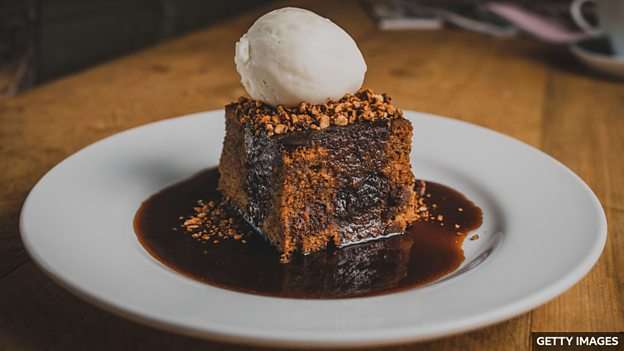内容简介
“酥脆的”、“鲜嫩多汁的”、“黏糊糊的”……这些在中文里用来形容食物口感的单词相对应的英语表达是什么?主持人 Georgie 和步理在本期节目中介绍一些用来形容食物的常见单词。一起听节目,学习如何用 “delicious(美味的)” 以外的单词来准确地为他人形容一道美食的口感吧!
文字稿
(关于台词的备注: 请注意这不是广播节目的逐字稿件。本文稿可能没有体现录制、编辑过程中对节目做出的改变。)
Buli
大家好,欢迎收听 BBC 英语教学的 “你问我答” 节目。I'm Buli.
Georgie
And I'm Georgie. We have a question here from one of our listeners.
Question
你好,请问如何准确地用英文描述不同食物的口感,而不仅仅是说 “delicious” 或 “tasty”?可以分享一些常用的形容词或表达吗?
Buli
By the way, what was the food like at that five-star restaurant you went to, Georgie?
Georgie
Oh, it was good! Very tasty.
Buli
OK… Is that it? No more details? Well, you wouldn't be a very good food critic, Georgie. 那么,想要准确、具体地形容某种食物的口味和口感时,我们可以使用哪些单词和表达呢?
Georgie
OK, starting with 'crispy'. Crispy foods have quite a hard texture and make a noise when you bite them. Think of snacks like nuts or crisps. You can make foods crispy by frying them. Let's hear some examples.
Examples
Deep-fry the dumplings until they're crispy on the outside and soft in the middle.
(将饺子放在油中炸至外酥里软。)
Dad likes his pizza crust crispy, but I prefer mine soft so it doesn't hurt my mouth.
(爸爸喜欢口感酥脆的披萨饼边,但我更喜欢软一些的,这样吃的时候不会伤到嘴。)
Buli
单词 “crispy” 的意思是 “酥脆的”,通常用于形容类似薯片、酥皮等薄而脆的食物。而和 “crispy” 类似的单词 “crunchy” 也可以用于形容 “口感偏硬、咬起来嘎吱嘎吱”的食物,意思是 “松脆的,嚼起来硬而脆的”。
Georgie
Yes. However, 'crunchy' extends to fruits and vegetables like carrots and apples that make a 'crunch' noise when you bite into them. But you could not use 'crispy' in the same way. Let's hear another example.
Example
I can't stand the noise of people eating crunchy foods in the office.
(我受不了别人在办公室里吃硬脆的东西时发出的声音。)
Buli
和 “crispy” 相比,“crunchy” 还有一个不同之处,那就是它还可以用来形容类似胡萝卜或苹果等口感酥脆的水果和蔬菜,特别是在咀嚼时会发出响声的食物。实际上,“crunchy” 的动词和名词形式 “crunch” 不但可以表示 “嘎吱嘎吱地嚼”,还可以描述 “吃口感发硬的东西时发出的嘎吱嘎吱的声音”。
Georgie
OK, so crispy and crunchy are food textures which tend to make a noise when eating them. Let's move on to textures related to liquid: juicy, succulent, moist and soggy. Juicy is another word which can describe an apple, or any fruit which is full of juice.
Buli
是的。“Juicy(多汁的,汁液丰富的)” 不但可以用来形容水分丰富的水果,还可以用来形容牛排或其它口感鲜嫩多汁的食物。类似的形容词还有 “succulent(美味多汁的)”,它们都可以被用来形容水果和肉类。来听两个例句。
Examples
There's nothing better than a ripe mango – they're incredibly juicy!
(没有什么比一个熟透了的芒果更加美味的水果了,它们汁多味美!)
The restaurant is famous for its succulent steak – they cook it only briefly.
(这家餐厅以其美味多汁的牛排而闻名,他们的做法是用猛火快煎。)
Georgie
Both 'juicy' and 'succulent' have positive connotations, whereas 'moist' means slightly wet and is neutral. You might want the food to be a little moist, or you might not. It depends on the food and the preference at the time.
Buli
是的。和 “juicy” 和 “succulent” 比起来,“moist(含水的,湿润的)” 在形容食物时比较中性,表示一种和 “dry(干的,干燥的)” 相对的 “鲜的、饱满的口感”。但如果食物 “湿乎乎、软塌塌的,口感黏糊不好吃”,那么就可以用 “soggy” 这个词来形容。
Examples
That cake is cooked to perfection – lovely and moist and not too dry.
(这个蛋糕烤得几乎完美,好看又松软,一点也不干。)
Let's leave the cake in the oven for ten more minutes. It's still a bit soggy.
(咱们把蛋糕在烤箱里再多烤十分钟吧。现在还是有些湿漉漉、软塌塌的。)
Buli
最后,让我们再来学习几个常用来形容面包和糕点的单词。在吃这类食物时,通常会容易掉渣或碎裂,这时我们就可以用 “flaky(容易掉渣的)” 和 “crumbly(易碎的)” 来描述它们。
Georgie
Now, imagine a doughnut filled with something soft like chocolate, jam or cream. 'Gooey' describes what's inside and means soft and sticky. If you squeeze the doughnut, the inner core will ooze out. Let's hear some examples.
Examples
Make sure you eat this tart on a plate, or it'll go all over the floor. It's very crumbly.
(一定要用盘子接着吃这个蛋糕挞,不然会弄得满地都是。它很容易碎。)
If you put the cheese in the oven, it will come out with a gooey centre.
(如果你把奶酪放进烤箱里,拿出来的时候它的中间就会变得黏糊糊的。)
Georgie
Ooh this is all making me very hungry. Remember, if you have a question that you'd like us to answer, you can email us too at questions.chinaelt@bbc.co.uk
Buli
你也可以通过微博向我们提问。我们的微博账号是 “BBC英语教学”。Bye!
Georgie
Good-bye!

